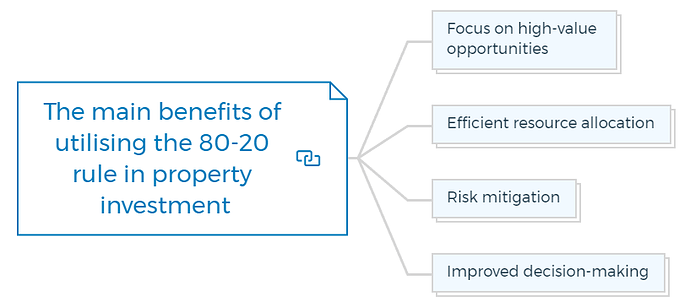80-20 Rule and Future Property Supply
Let’s start this chapter by understanding the 80/20 ratio rule in marketing and how it affects our sales.
What is the main principle of the 80-20 rule or Pareto principle?
The 80/20 rule is also known as the Pareto Principle, which transcends many aspects of our everyday life and practices. The rule states:
- 80 per cent of what you get comes from 20 per cent of what you do: small effort, big reward.
- 20 per cent of what you get comes from the other 80 per cent you do: Big effort, small reward.
The 80/20 rule applies to just about every aspect of the business. Sources of incoming phone calls, sizes of commissions for salespeople, and the physical location of customers can all benefit from applying the 80/20 principle.
By applying the 80/20 rule in the business world, we can say that 80% of the company’s sales come from 20% of the customers.
This implies that 20% of what you do represents 80% of the outcome of that particular activity. In the sales and marketing ecosystem, the 80/20 ratio can work as a guide to navigate your way through some tough decisions and develop highly effective business solutions.
You are missing out if you haven’t yet subscribed to our YouTube channel.
What is the 80-20 rule for property suppliers?
Once the same principle in the property development procedure has been applied, around 20% of your buyers will produce 80% of the sales. The same rule also applies to the property where every 2 out of 10 people become genuine buyers.
This brings our attention to another critical aspect of marketing, which is advertising. If we apply the 80/20 ratio to the advertising aspect, we can obtain the highest yield in terms of responses and customers.
80% of potential buyers will come from within 20km of the project. This is a helping tool in determining the target audience, the target market as well as the target location.
Learn More
For example, we all know that marketing is a big risk and requires vast chunks of capital. Thus, you wouldn’t want to spend your precious dollars in the direction where their worth is the least.
Whenever you market a property, you aim for the most effective responses. An effective or influential market isn’t entirely one that reaches out to the maximum audience. The most effective marketing is the one that reaches out to the correct audience who value your product, regardless of their quantity.
Now there are different ways you can do real estate marketing or a property development advertisement.
You need to select your desired medium and make sure that your marketing strategy lays higher emphasis on the area within the proximity of 20 kilometres because that’s what’s going to bring 80% of your audience to the product you have developed.
Future property supply
With a cooling housing market, it’s a good time to look at factors that may influence housing in the future and how these trends could affect residential real estate investors.
It is good to be prepared in advance to develop marketing and planning strategies according to the evolving surroundings.
Increase in population
Australia’s population will reach forty-two million by 2050, which is six million more than the Federal Government’s target if migration, fertility, and life expectancy rates continue at the same pace as today.
Australia’s population has grown by an average of 1.5% per annum over the last decade. This is one of the highest growth rates in the developed world, well above the global average of 1.1% per annum.
Australia’s population typically grows by 200,000 to 400,000 people from year to year. The average annual population increase over the last 15 years is 305,000.
According to the 2015 population statistics data, our population growth eased slightly to 316,000 people (1.4% growth and still a lot of extra demand for accommodation).
Thus, to close more deals, the choice selection would be those places with more population. Australia’s major cities, such as Sydney, Melbourne, Brisbane, and Perth, receive most of the attention in this scenario.
The 80-20 rule, in this context, emphasises that a small portion of property owners may significantly influence supplying housing options to meet the demands of the expanding population.
More and more people who opt for emigration choose to prefer cosmopolitan cities for several reasons, such as:
- Inclusive, vibrant, and healthy neighbourhoods
- A sustainable and resilient city
- Transport for a growing city
- Productive and innovative city
- Affordable and accessible housing
- Adequate resources and amenities in the closest proximity
The strong population growth in Melbourne and Sydney has been a key factor in their property performance.
Even now, as housing prices subside, investors, owner-occupiers, and developers comfort themselves that in the long run, in the expectation of another 2-3 million people in each city, rental growth and capital gain will re-emerge.
Shortage of housing in Australia
The most recent topic that has been brought to light by the press and media is the increasing population in Australia and its consequences. The topic still needs to be determined whether there is a housing shortage in Australia due to the increasing population.
It appears that, at worst, Australia’s reported housing shortage will not worsen, and, at best, it will improve, with Fitch forecasting a surge in construction to continue keeping up with strong population growth, mainly due to immigration.
To invest sustainably, a location must have the essential infrastructure to retain its population. It is also said (and proved) that the size of the population, whether big or small, does not play any significant role in the growth of the prices of the property.
Generally, the location with a more significant population already has high housing prices, so that the growth potential can be less than the locations with smaller populations.
The 80-20 rule suggests that a minority of property owners may hold a significant portion of available properties, potentially exacerbating the housing shortage.
This concentration of ownership can contribute to limited supply and higher property prices, making it challenging for many individuals and families to find affordable housing.
Housing affordability
The term’ housing affordability’ refers to the relationship between average expenditure on housing (prices, mortgage payments, and rents) and average household income.
A major rating agency forecasts the growth in Australian homes to slow down as the nation approaches an “affordability ceiling.”
Historic events and functions further reinforce this. In the late 2000s, housing prices in Australia were ranked amongst the highest in the world.
As for 2011, the housing prices exceeded six times the average household income. Compared to 1990, this rate increased four times.
With almost 25 years of continuous GDP growth, record low rates and stable unemployment, Fitch expects Australian prices to remain high, and affordability will likely worsen shortly before levelling off as it reaches an affordability ceiling.
The issue of housing affordability is closely linked to the 80-20 rule and future property supply. As property prices increase due to various factors, including the concentration of ownership, a significant portion of the population may need help to afford suitable housing.
Affordability concerns are particularly relevant for first-time buyers, low-income households, and younger generations looking to enter the property market.
Addressing housing affordability requires a multi-faceted approach that considers the 80-20 rule’s impact on supply dynamics.
Demographic shift
Moreover, another contributing factor to the apartment building is the demographical shift; for instance, more people are marrying late. Thus, a bachelor’s life (or not starting a family anytime soon) only requires one to acquire big properties.
Hence, the youth, as well as the immigrants, both prefer apartments as a means of accommodation.
The 80-20 rule highlights the importance of understanding these demographic shifts and tailoring property supply accordingly.
What are the main benefits of utilising the 80-20 rule in property investment?
The 80-20 guideline can help property investing. The principle’s benefits for property investment are:
Focus on high-value opportunities
The 80-20 rule shows that a few properties generate most of the market’s value. Property owners can focus on high-value investments by knowing this approach.
Investors can maximise returns by targeting assets with high appreciation potential and appealing yields.
Efficient resource allocation
The 80-20 rule states that a minority of inputs or efforts yield the bulk of outputs. In property investment, a few properties will make the most of the money.
Investors can better manage time, funds, and energy by discovering these high-performing assets. This improves decision-making, reduces risk, and optimises investment plans.
Risk mitigation
Property investors can reduce risk by utilising the 80-20 rule. Investors can reduce risk by focusing on top-performing assets. This selective method creates a more targeted and informed investing portfolio, lowering losses and improving risk management.
Improved decision-making
Property investment using the 80-20 rule supports data-driven and analytical decision-making. Investors can use the approach to analyse market trends, property performance, and critical elements that make top-performing properties.
This knowledge helps investors seize opportunities, negotiate better bargains, and align their investments with market dynamics.
Test Your Knowledge
Understanding the 80-20 Rule in Property Supply: A Practical Exercise
Objective
This assignment aims to deepen students’ understanding of the 80-20 rule (Pareto Principle) in the context of property supply, its implications on sales, marketing, and the real estate market, including factors affecting future property supply. Through research, analysis, and practical application, students will explore how the 80-20 rule can guide property investment decisions and strategies.
Part 1: The Basics of the 80-20 Rule
Questions:
Define the 80-20 Rule
In your own words, explain the 80-20 rule and its general application in business and everyday life.
Application in Sales and Marketing
How does the 80-20 rule apply specifically to sales and marketing within the property market?
Identifying the Top 20%
Based on the principle that 20% of customers generate 80% of sales, propose a method for identifying these top 20% customers in the real estate industry.
To Do:
Research Assignment
Investigate three successful real estate companies and identify how they might be applying the 80-20 rule in their business strategies. Present your findings in a brief report, highlighting specific strategies that align with the Pareto Principle.
Part 2: The 80-20 Rule in Property Supply and Investment
Questions:
Property Suppliers’ Perspective: How does the 80-20 rule affect property suppliers and their sales strategies?
Marketing Focus: Discuss the significance of focusing marketing efforts within a 20km radius of a property project. How does this strategy align with the 80-20 rule?
To Do
Case Study Analysis
Choose a local property development project. Analyze its marketing strategy to determine if it follows the 80-20 rule, focusing on targeting potential buyers within a 20km radius. Discuss the effectiveness of this strategy based on the information available.
Part 3: Future Property Supply and Demographic Shifts
Research Questions:
Population Growth and Housing Demand
How does the projected population growth in Australia impact future property supply and demand?
Housing Affordability and the 80-20 Rule
Discuss the relationship between housing affordability, the 80-20 rule, and future property supply. How can this principle help address affordability concerns?
To Do:
Group Discussion
In groups, debate the potential long-term effects of applying the 80-20 rule to address housing shortages and affordability issues in major Australian cities. Consider both the benefits and limitations of this approach.
Part 4: Utilizing the 80-20 Rule in Property Investment
Questions:
High-Value Opportunities
How can property investors use the 80-20 rule to identify and focus on high-value investment opportunities?
Risk Mitigation
Explain how applying the 80-20 rule can help property investors mitigate risks.
To Do:
Portfolio Analysis Exercise: Create a hypothetical property investment portfolio. Using the 80-20 rule, identify which properties (or types of properties) would likely yield the highest returns and justify your selections based on market analysis and the principles discussed.
Submission Guidelines:
- Complete all sections of the assignment, providing detailed answers and analysis.
- For research assignments and case studies, cite at least three credible sources.
- For the group discussion and portfolio analysis, provide a summary of your findings and conclusions.
- Submit your assignment via mail or comments.







